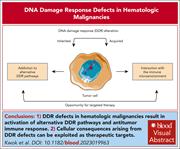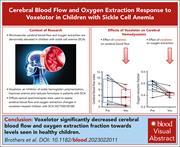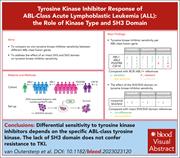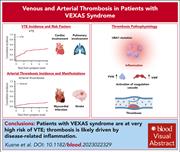Issue Archive
Table of Contents
BLOOD COMMENTARIES
REVIEW ARTICLE
DNA damage response defects in hematologic malignancies: mechanistic insights and therapeutic strategies
Kwok and colleagues review the role of defective DNA damage response (DDR) in hematologic malignancy. While germ line DDR alterations lead to hereditary chromosome instability and increased hematologic malignancies (HMs), many de novo HMs display acquired variants in DDR genes that confer clonal growth advantage. The authors reviewed the potential for targeting functional dependencies arising from these defects as well as the role of DDR defects in tumor immunogenicity, suggesting that DDR modulation may synergize with immunotherapy of HMs.
CLINICAL TRIALS AND OBSERVATIONS
The influence of voxelotor on cerebral blood flow and oxygen extraction in pediatric sickle cell disease
Clinical Trials & Observations
Severe anemia in sickle cell disease (SCD) reduces cerebral oxygen delivery, which is compensated by an increase in cerebral blood flow (CBF) and oxygen extraction fraction (OEF). Voxelotor increases hemoglobin oxygen affinity, reducing sickling and hemolysis and increasing blood hemoglobin levels. However, it is debated whether reduced oxygen delivery could counter these salutary effects on hemoglobin. In a preliminary study of 8 patients with SCD before and after voxelotor treatment, Brothers et al demonstrate decreased CBF and OEF toward normal levels, suggesting that voxelotor normalizes cerebral hemodynamics.
IMMUNOBIOLOGY AND IMMUNOTHERAPY
CD19-CD28: an affinity-optimized CD28 agonist for combination with glofitamab (CD20-TCB) as off-the-shelf immunotherapy
Sam and colleagues present preclinical data regarding a novel bispecific CD19-targeted CD28 agonist to enhance the efficacy of glofitamab, a CD20 T-cell bispecific antibody (TSB) that directs T cells to CD20-expressing malignant B cells. This CD19-CD28 TSB is an “off-the-shelf” product that in studies in humanized mice enhances the antitumor efficacy of glofitamab and now awaits clinical evaluation.
LYMPHOID NEOPLASIA
Targeting the TNF/IAP pathway synergizes with anti-CD3 immunotherapy in T-cell acute lymphoblastic leukemia
T-cell acute lymphoblastic leukemia (T-ALL) is generally treated with intensive chemotherapy, but many patients relapse. Ávila Ávila and colleagues previously reported that targeting the T-cell receptor with anti-CD3 monoclonal antibodies impaired leukemia progression, but in murine models, responding mice still relapsed. Here, the authors identify that resistant cells are dependent on tumor necrosis factor (TNF) signaling and that targeting TNF or its downstream target, second mitochondrial-derived activator of caspases, improves anti-CD3 immunotherapy in a preclinical model of T-ALL.
Tyrosine kinase inhibitor response of ABL-class acute lymphoblastic leukemia: the role of kinase type and SH3 domain
BCR::ABL1-like (Ph-like) acute lymphoblastic leukemia (ALL) is driven by fusions of ABL-class tyrosine kinase genes other than BCR::ABL1. van Outersterp and colleagues characterize the profile of tyrosine kinase inhibitor (TKI) sensitivity of the 4 tyrosine kinase genes implicated in these gene fusions. All samples were relatively sensitive to imatinib while there was divergence in response to dasatinib and bosutinib, suggesting that the choice of TKI for Ph-like ALL depends on the involved tyrosine kinase gene.
THROMBOSIS AND HEMOSTASIS
Venous and arterial thrombosis in patients with VEXAS syndrome
Clinical Trials & Observations
VEXAS (vacuoles, E1 enzyme, X-linked, autoinflammatory, somatic) syndrome is an autoinflammatory disorder with wide-ranging manifestations, caused by somatic mutations in the ubiquitin-like modifier activating enzyme 1 gene. Kusne et al describe thrombosis in patients with VEXAS in a cohort of 119 patients. Thromboembolism was common, seen in 49% of patients, mostly venous thromboembolism (VTE) (41%). VTEs were unprovoked in over 60% of patients with a recurrence rate of 41%, 20% of which occured despite anticoagulation. The mechanism of this frequent complication is unknown but correlates with inflammatory manifestations, suggesting that thromboprophylaxis should be considered in high-risk settings, including with acute inflammation.
TRANSPLANTATION
Alloengraftment without significant toxicity or GVHD in CD45 antibody-drug conjugate–conditioned Fanconi anemia mice
Fanconi anemia (FA) is an inherited disorder of DNA repair associated with bone marrow failure, developmental abnormalities, and a predisposition to myeloid malignancy and solid tumors. Allogeneic transplantation is limited by toxicity associated with conditioning. Saha and colleagues report on preclinical studies using a single dose of an antibody-drug conjugate (ADC) targeting CD45 that facilitates engraftment in FA mouse models. CD45-ADC was myeloablative, did not cause toxicity, and led to 60%-90% engraftment, supporting a clinical evaluation of this approach in patients with FA.
BLOOD WORK
-
Cover Image
Cover Image
![issue cover]()
Micrograph depicting human CD8 T cells (cyan) within a xenograft tumor after administration of glofitamab in humanized mice clustering around blood vessels (green) and the stromal compartment where the adhesion molecule ICAM1 (red) is expressed. See the article by Sam et al on page 2152.
- PDF Icon Front MatterFront Matter
- PDF Icon Table of ContentsTable of Contents
- PDF Icon Editorial BoardEditorial Board
Advertisement intended for health care professionals
Email alerts
Advertisement intended for health care professionals









